
Herbals

Scientific name : Ocimum tenuiflorum
Tulasi is cultivated for religious and medicinal purposes, and for its essential oil. It is widely known across the Indian subcontinent as a medicinal plant and a herbal tea, commonly used in Ayurveda, and has an important role within the Vaishnava tradition of Hinduism, in which devotees perform worship involving holy basil plants or leaves. This plant is revered as an elixir of life.
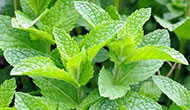
Scientific name : Mentha × piperita
Peppermint is one of the most popular flavoring agents. Many products contain peppermint, including chewing gum, mints and candies, ice cream and other sweets, tobacco, toothpaste, mouthwash, cough drops, teas, alcoholic liqueurs, and digestive aids . It is also used to scent soaps, perfumes, detergents, lipsticks and other cosmetics, and is an ingredient in many over-the-counter medications. Therapeutically, peppermint is used to treat many ailments of the skin, circulatory system, respiratory system, digestive system, immune system, and nervous system.

Scientific name: Arutha (Ruta Graveolens)
Ruta Graveolens is an perennial shrub that grows to a height of about 4-5. The plant bears bunches of yellow flowers with about one cm diameter. The fruits bear many seeds.
Uses: Use of arutha as a vegetable or for culinary purpose is almost completely absent in India. It is reported that arutha had culinary importance in such cultures like Greek.

Scientific name: Allium sativum
Allium sativum is a bulbous plant. It grows up to 1.2 m (4 ft) in height. Its hardiness is USDA Zone 8. It produces hermaphrodite flowers. It is pollinated by bees and other insects.
Uses: Garlic is widely used around the world for its pungent flavor as a seasoning or condiment.The garlic plant's bulb is the most commonly used part of the plant. With the exception of the single clove types, garlic bulbs are normally divided into numerous fleshy sections called cloves. Garlic cloves are used for consumption (raw or cooked) or for medicinal purposes. They have a characteristic pungent, spicy flavor that mellows and sweetens considerably with cooking.
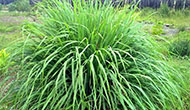
Scientific name: Cymbopogon
Lemongrass, Cymbopogon citratus, is a perennial grass in the family Poaceae grown for its fragrant leaves and stalks which are used as a flavoring. The grass grows in dense clumps and has several stiff stems and slender blade-like leaves which droop towards the tips. The leaves are blue-green in color, turning red in the Fall and emit a strong lemon fragrance when damaged. Lemongrass produces large compound flowers on spikes when grown in the tropics, but rarely flowers when grown in more Northern latitudes. Lemon grass can reach a height of 1.8 m (6 ft) and will grow for several years, typically its economical lifespan is 4 years. Lemongrass may also be referred to as ginger grass or citronella grass and likely originates from Sri Lanka or Malaysia although a wild form of the plant is not known.
Uses: The stalks (leaf bases) of the plant are commonly used to flavor dishes in Southeast Asian cooking. The heart of young shoots may be cooked and consumed as a vegetable. The tougher leaves are used to flavor dishes but are typically removed before serving. Leaves may also be used to make lemon grass tea. The essential oil extracted from the leaves is commonly used in insect repellents, perfumes and soaps.
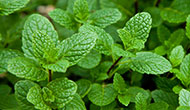
Scientific name: Mentha arvensis
Mints belong to the genus Mentha and comprise approximately 20 species in the plant family Lamiaceae and are growm for their leaves which are widely used as a flavoring. The leaves are often covered in tiny hairs and have a serrated margin.
Uses: Indigestion and gas: Mint is a calming and soothing herb that has been used for thousands of years to aid with upset stomach or indigestion. ... Peppermint is also thought to relieve pain and discomfort from gas and bloating. Peppermint tea is a common home remedy for flatulence.
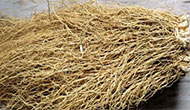
Scientific name: Chrysopogon zizanioides
Vetiver or khus (Vetiveria zizanioides) is a tall, perennial grass which grows wild in drier, periodically flood inundated tracts, of western and north-central India. It produces spongy, much branched, root system (khus roots) with fine rootlets, containing a fragrant oil which is a perfume by itself. The dry aromatic roots are also used to make curtains, mats, fans and other fancy goods as the product emits a sweet cooling aroma for a long period when moistened. The oil is used as a valuable fixative in blending of perfumes, cosmetics and scenting of soaps.
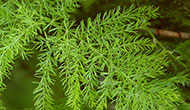
Scientific name: Asparagus racemosus
Shatavari is a climbing plant which grows in low jungles areas throughout India. This sweet and bitter herb is particularly balancing to Pitta Dosha.
Uses: The healing qualities of Shatavari are useful to a wide array of ailments. It is well known for it effects on the female reproductive system. It is also effective in a number of other systems of the body and is therefore of use to both men and women.
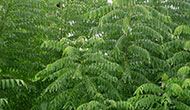
Scientific name: Murraya koenigii
It is a small tree, growing 4–8.7 m (13–31 feet) tall, with a trunk up to 81 cm (32 in) diameter. The aromatic leaves are pinnate, with 11–21 leaflets, each leaflet 2–4 cm (0.79–1.57 in) long and 1–2 cm (0.39–0.79 in) broad. The plant produces small white flowers which can self-pollinate to produce small shiny-black berries containing a single, large viable seed. Though the berry pulp is edible—with a sweet but medicinal flavour—in general, neither the pulp nor seed is used for culinary purposes.
Uses: The leaves are highly valued as seasoning in southern and west-coast Indian cuisine, and Sri Lankan cuisine especially in curries, usually fried along with the chopped onion in the first stage of the preparation. They are also used to make thoran, vada, rasam and kadhi. In their fresh form, they have a short shelf life and do not keep well in the refrigerator. They are also available dried, though the aroma is largely inferior. Leaves can also be harvested from home-raised plants as it is also fairly easily grown in warmer areas of the world, or in containers where the climate is not supportive outdoors.The leaves of Murraya koenigii are also used as an herb in Ayurvedic medicine
Herbal Products
-
Bamboo Rice
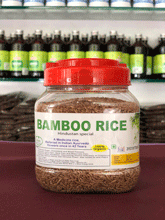
Controls Sugar, Cholesterol and Blood Pressure. Controls Joints Pain, Back pain. Good for Blindness, Overcoming vitamin deficiency. Increase sexual ability and improves immunity power.
-
Bamboo Rice Powder
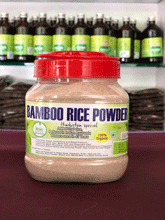
Controls Sugar, Cholesterol and Blood Pressure. Controls Joints Pain, Back pain. Good for Blindness, Overcoming vitamin deficiency. Increase sexual ability and improves immunity power. Can be use to make Rotti, Chapathi, Dosa, Uppuma and mix with boiled milk is a good energy drink.
